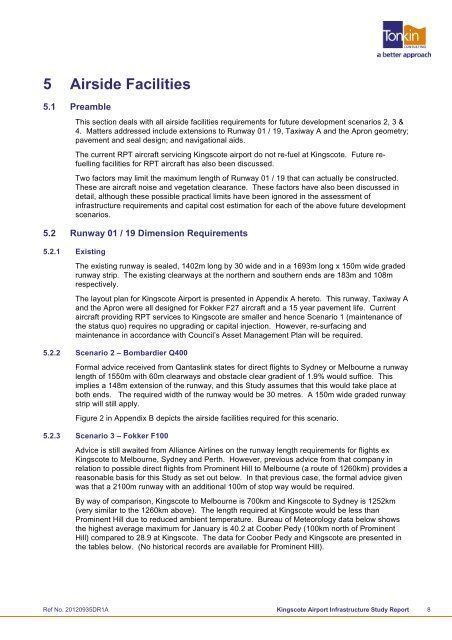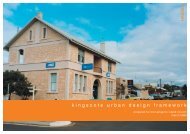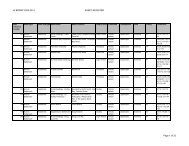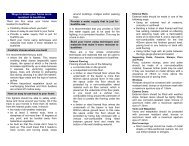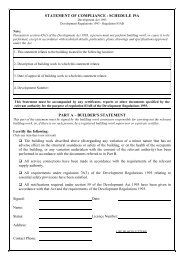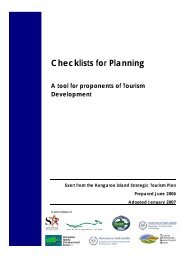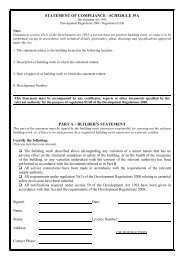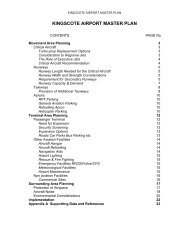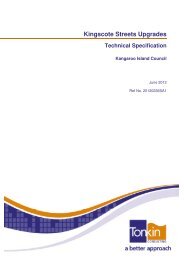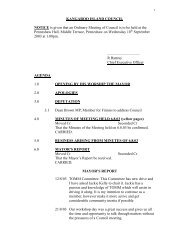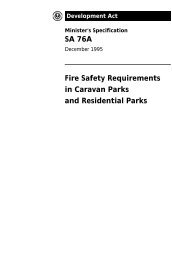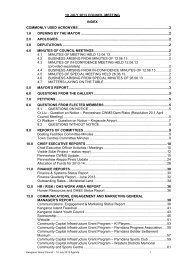Kingscote Airport Business Case Appendices - Kangaroo Island ...
Kingscote Airport Business Case Appendices - Kangaroo Island ...
Kingscote Airport Business Case Appendices - Kangaroo Island ...
- No tags were found...
Create successful ePaper yourself
Turn your PDF publications into a flip-book with our unique Google optimized e-Paper software.
5 Airside Facilities5.1 PreambleThis section deals with all airside facilities requirements for future development scenarios 2, 3 &4. Matters addressed include extensions to Runway 01 / 19, Taxiway A and the Apron geometry;pavement and seal design; and navigational aids.The current RPT aircraft servicing <strong>Kingscote</strong> airport do not re-fuel at <strong>Kingscote</strong>. Future refuellingfacilities for RPT aircraft has also been discussed.Two factors may limit the maximum length of Runway 01 / 19 that can actually be constructed.These are aircraft noise and vegetation clearance. These factors have also been discussed indetail, although these possible practical limits have been ignored in the assessment ofinfrastructure requirements and capital cost estimation for each of the above future developmentscenarios.5.2 Runway 01 / 19 Dimension Requirements5.2.1 ExistingThe existing runway is sealed, 1402m long by 30 wide and in a 1693m long x 150m wide gradedrunway strip. The existing clearways at the northern and southern ends are 183m and 108mrespectively.The layout plan for <strong>Kingscote</strong> <strong>Airport</strong> is presented in Appendix A hereto. This runway, Taxiway Aand the Apron were all designed for Fokker F27 aircraft and a 15 year pavement life. Currentaircraft providing RPT services to <strong>Kingscote</strong> are smaller and hence Scenario 1 (maintenance ofthe status quo) requires no upgrading or capital injection. However, re-surfacing andmaintenance in accordance with Council’s Asset Management Plan will be required.5.2.2 Scenario 2 – Bombardier Q400Formal advice received from Qantaslink states for direct flights to Sydney or Melbourne a runwaylength of 1550m with 60m clearways and obstacle clear gradient of 1.9% would suffice. Thisimplies a 148m extension of the runway, and this Study assumes that this would take place atboth ends. The required width of the runway would be 30 metres. A 150m wide graded runwaystrip will still apply.Figure 2 in Appendix B depicts the airside facilities required for this scenario.5.2.3 Scenario 3 – Fokker F100Advice is still awaited from Alliance Airlines on the runway length requirements for flights ex<strong>Kingscote</strong> to Melbourne, Sydney and Perth. However, previous advice from that company inrelation to possible direct flights from Prominent Hill to Melbourne (a route of 1260km) provides areasonable basis for this Study as set out below. In that previous case, the formal advice givenwas that a 2100m runway with an additional 100m of stop way would be required.By way of comparison, <strong>Kingscote</strong> to Melbourne is 700km and <strong>Kingscote</strong> to Sydney is 1252km(very similar to the 1260km above). The length required at <strong>Kingscote</strong> would be less thanProminent Hill due to reduced ambient temperature. Bureau of Meteorology data below showsthe highest average maximum for January is 40.2 at Coober Pedy (100km north of ProminentHill) compared to 28.9 at <strong>Kingscote</strong>. The data for Coober Pedy and <strong>Kingscote</strong> are presented inthe tables below. (No historical records are available for Prominent Hill).Ref No. 20120935DR1A <strong>Kingscote</strong> <strong>Airport</strong> Infrastructure Study Report 8


